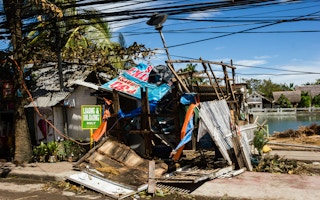Policy commitments to reduce disaster risk with additional funding sound right, but actually they miss the point.
Financing by national governments has a lower profile than some of the other perceived weaknesses of the existing Hyogo Framework for Action (HFA) on disaster risk reduction (DRR): the disconnect between its five ‘priorities for action’; a lack of attention to the challenge of doing DRR in complex contexts; a focus on process rather than outcomes; and a tendency to separate out disaster risk from wider development.
But financing is key to the future of DRR. The weakness of its articulation and absence of firm commitments in the original framework have been a major drag on progress in reducing risk.
This week, U.N. member states are meeting in Geneva at a preparatory event to discuss the successor to the HFA, likely to be agreed at the World Conference on DRR in Japan next March.
Financing is on the agenda and the next nine months until the conference offer an opportunity to make a significant advance. But exactly what advance can be expected remains unclear.
Financing Models
Much of the past rhetoric on DRR financing has focused on increasing off-budget volumes. Even today this viewpoint holds sway with many in the DRR community.
For example, some focus on the creation of a large global fund for DRR, resourced perhaps through an agreement on loss and damage payments to be made by developed countries under future climate negotiations, or through the U.N. Green Climate Fund, which may take the lion’s share of a proposed $100 billion per year in climate finance.
These ideas point to a model in which heavily increased investments directed to DRR from the international community are central to the future reduction of disaster risk.
The problems with such an approach are significant. First, it is very unlikely that such a fund would ever have the resources to really reduce risk across the full range of developing countries in need.
Second, it would shift the emphasis from national governments to the international community, driving leadership and decision-making away from the direction in which it should move.
And finally - and most importantly - standalone financing of DRR is not the solution to national risk reduction since it is targeting the wrong thing.
Private sector risk
This doesn’t mean standalone financing of DRR is of little use. In fact it can fund very important activities such as the creation and maintenance of national disaster and risk authorities, the development of early warning systems, multi-sector risk assessments, and country and community preparedness.
Nor does it mean there is no role for the international community. Too often in the past, international efforts to support countries with DRR have been fragmented across many projects, as well as different implementers with different objectives. It is also clear from the evidence that low-income countries - those most in need of international support but which have ironically received the least - need additional, dedicated and sustained support for reducing risk.
But the bulk of disaster risk being added in most countries is through private-sector development (between 70 and 85 percent according to the United Nations), with public-sector development coming a clear second.
Financing of DRR as a standalone issue, whether from national or international sources, is likely to do little to tackle the massive amounts of risk being created across both private and public sectors.
The evidence to date - some of it presented in a new report released by the Overseas Development Institute, and funded by the U.N. Development Programme - suggests there is still much work to do, and even the most successful countries need to improve the coordination and coherence of their DRR financing.
The first step on this path is recognising the critical role of financing for sustainable development, rather than for DRR alone. Spending to reduce disaster risk should be part and parcel of normal development planning and budgeting.
The second step entails a shift in attention from specialised DRR agencies to long-term development financing led by ministries of economy, planning and finance.
And the third step is a global one: the financing of DRR needs to move from the next global disaster reduction framework to the Sustainable Development Goals, which will be launched by the United Nations at the start of 2016.
Jan Kellett is the lead author of the Overseas Development Institute’s Financing disaster risk reduction: Towards a coherent and comprehensive approach report, and was a senior research advisor at ODI when this blog post was written. He is now disaster and climate partnerships advisor at the U.N. Development Programme. This post originally appeared on Thomson Reuters Foundation’s Alertnet.











